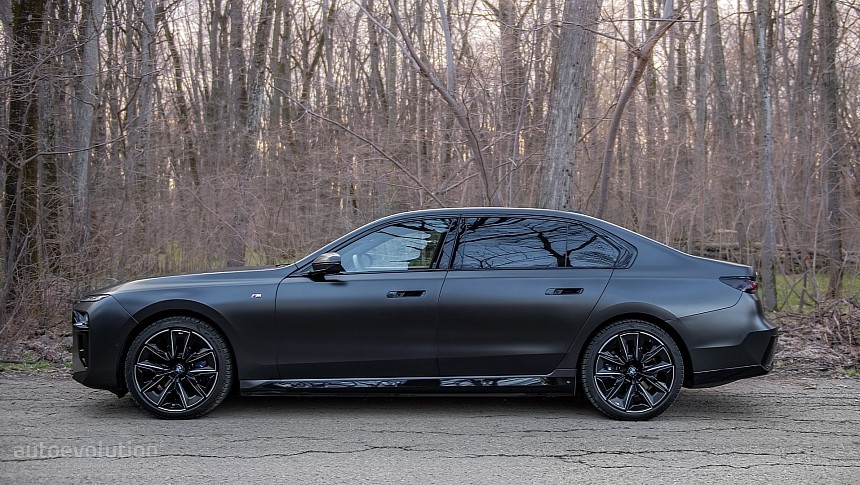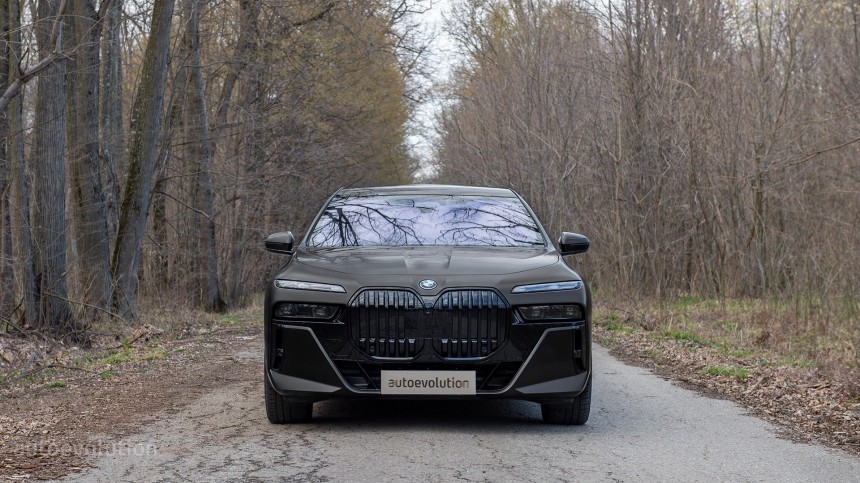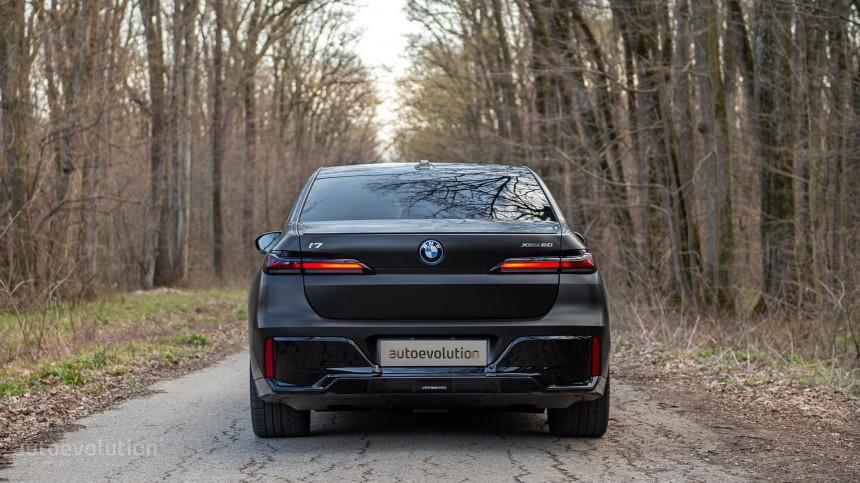Carbon is the building block of life but not the building block of mainstream cars, apparently. This is probably why BMW has chosen to develop all its current and upcoming 'i' cars based on their ICE counterparts instead of developing ultra-light platforms designed from the get-go to be electric.
Back in 2013 and 2014, respectively, BMW was taking the premium car landscape by storm with the introduction of two highly unusual models. Part of a then-unveiled sub-brand called 'BMW i,' the i3 and i8 were a pair of electrified offerings that couldn't be more different from each other even if they tried (which they did).
The i3 was the culmination of the so-called Mega City Vehicle project, and it followed BMW's principles of electric urban transport to the letter. It was a sub-compact electric car with tiny suicide rear doors and an ultra-light Carbon Fiber Reinforced Plastic (CFRP) monocoque bonded on top of an aluminum skateboard chassis.
The i8, on the other hand, was the closest thing in desirability to a proper carbon-fiber supercar without costing as much as one. Both models were a love letter to the future of electric transportation, and yet BMW pulled the plug (pun intended) on both.
The Bavarians then decided that the 2.0 iteration of the 'i' project will be based on more down-to-earth modular ICE platforms, which don't feature CFRP and other similar space-age materials as much as their predecessors.
Enter the BMW i7, which you shouldn't disparage as just an electric version of the latest G70 generation 7 Series, although in many ways, that's exactly what it is. To talk about the i7 is to first understand where it's coming from, and especially where it's going.
Its architecture and the entire car, including most of its features, exterior and interior design, and measurements, are identical to its ICE brother's.
We tested the only powertrain version initially available, called the i7 xDrive60, and found out it's more than just an electric 7 Series. It could actually be a full-blown BMW flagship sedan.
The two electric motors that comprise the powertrain were lifted straight out of the BMW i4 M50, another 'Project I 2.0' vehicle that is basically an electric version of the 4 Series GranCoupe.
This translates into a motor that powers the front axle with up to 254 horsepower and 269.2 lb-ft of torque (258 PS and 365 Nm) and another one at the rear with up to 309 horsepower and 280.3 lb-ft of torque (313 PS and 380 Nm).
Because it's electric and the math doesn't add up like you were taught in school, the combined oomph of the BMW i7 xDrive60 is 537 horsepower and 549 lb-ft of torque (544 PS and 745 Nm).
According to official BMW data, all that oomph can move the bulky, monolithic design from 0 to 100 kph (62 mph) in 4.7 seconds and to a top speed of 240 kph (149 mph). We connected our RaceBox to our tester vehicle, equipped with 21-inch winter tires, and managed a best time of 4.74 seconds, which was a pleasant surprise considering the context and imperfect testing conditions.
The lithium-ion battery offers 105.7 kWh of juice, of which up to 101.7 kWh are available to the driver. This converts into a range of up to 388 miles (624 km) in WLTP testing or up to 318 miles (512 km) in EPA.
During our test drive, I averaged around 310 miles (500 km) on a single charge, driving in mixed conditions and without a lead foot most of the time. But like with any EV, driving conditions, the model’s spec, and the weight of your right foot will influence the numbers A LOT.
BMW is proud to acknowledge that the i7s NMC battery uses more nickel content while the cobalt content is reduced in the cathodes, with more silicon content on the anodes. In theory, this results in a greener manufacturing process for the battery.
The two synchronous induction motors use excited-field coils instead of permanent magnets. This avoids the need for rare-earth elements on one side and introduces a rather cool launch control gimmick on the other.
When in Sport mode, the Launch Control function uses the motors to literally vibrate the entire car before letting go of the brake and blasting from a dig like such a heavy car has no right to do.
Speaking of 'heavy,' in its most basic spec, the i7 xDrive60 weighs in at no less than 5,986 pounds (2,715 Kg), making it the opposite of a featherweight and even heavier than the not-so-light Mercedes-Benz EQS 580 4Matic.
All that weight is also crammed into a humongous sedan, with the i7 clocking a length of 212.2 inches (5,391mm), a width of 76.8 inches (1,950 mm), and a height of 60.8 inches (1.544 mm).
Thankfully, the standard rear-steering system, which can turn the rear wheels by up to 3.5 degrees, has a somewhat reasonable 40-feet (12.3-meter) turning circle. That's 2.5 feet (75 cm) less than the car would have had without the system.
The huge exterior size translates into a downright cavernous interior in almost all directions. This feature is also necessary to provide room for the so-called 'Theater Screen,' a 31-inch, 8K LCD touchscreen that reclines down from the ceiling like the spaceship from 'Arrival.'
Because of its unusual 10/3 aspect ratio, most movies you will watch on it will be either letterboxed or stretched, but the i7s optional Theater Mode provides a wondrous experience for the rear passengers, nonetheless.
You can also control its angle vertically and horizontally by using either the two 5.5-inch touchscreens inserted in the rear doors or the optional tablet from the center armrest.
With the available fully automatic opening and closing of the front and rear doors and the Bowers&Wilkins Surround Sound system, jumping inside the i7s interior feels like you are setting foot in Superman's spaceship.
Thankfully, if Clark Kent ever entered the latest 7 Series or the i7, he would not be greeted by kryptonite but by a plethora of crystals, with which BMW has drenched the interior.
Considering this, BMW DOES look to have a winner on its hands from a technical point of view. The i7 might be the best upgrade that the 7 Series needed in its quest for luxury sedan world domination... if you can stand its, let's say, peculiar design, that is.
The i3 was the culmination of the so-called Mega City Vehicle project, and it followed BMW's principles of electric urban transport to the letter. It was a sub-compact electric car with tiny suicide rear doors and an ultra-light Carbon Fiber Reinforced Plastic (CFRP) monocoque bonded on top of an aluminum skateboard chassis.
The i8, on the other hand, was the closest thing in desirability to a proper carbon-fiber supercar without costing as much as one. Both models were a love letter to the future of electric transportation, and yet BMW pulled the plug (pun intended) on both.
The Bavarians then decided that the 2.0 iteration of the 'i' project will be based on more down-to-earth modular ICE platforms, which don't feature CFRP and other similar space-age materials as much as their predecessors.
Enter the BMW i7, which you shouldn't disparage as just an electric version of the latest G70 generation 7 Series, although in many ways, that's exactly what it is. To talk about the i7 is to first understand where it's coming from, and especially where it's going.
From Dino Juice to Electron Juice
We tested the only powertrain version initially available, called the i7 xDrive60, and found out it's more than just an electric 7 Series. It could actually be a full-blown BMW flagship sedan.
The two electric motors that comprise the powertrain were lifted straight out of the BMW i4 M50, another 'Project I 2.0' vehicle that is basically an electric version of the 4 Series GranCoupe.
This translates into a motor that powers the front axle with up to 254 horsepower and 269.2 lb-ft of torque (258 PS and 365 Nm) and another one at the rear with up to 309 horsepower and 280.3 lb-ft of torque (313 PS and 380 Nm).
Because it's electric and the math doesn't add up like you were taught in school, the combined oomph of the BMW i7 xDrive60 is 537 horsepower and 549 lb-ft of torque (544 PS and 745 Nm).
According to official BMW data, all that oomph can move the bulky, monolithic design from 0 to 100 kph (62 mph) in 4.7 seconds and to a top speed of 240 kph (149 mph). We connected our RaceBox to our tester vehicle, equipped with 21-inch winter tires, and managed a best time of 4.74 seconds, which was a pleasant surprise considering the context and imperfect testing conditions.
The lithium-ion battery offers 105.7 kWh of juice, of which up to 101.7 kWh are available to the driver. This converts into a range of up to 388 miles (624 km) in WLTP testing or up to 318 miles (512 km) in EPA.
During our test drive, I averaged around 310 miles (500 km) on a single charge, driving in mixed conditions and without a lead foot most of the time. But like with any EV, driving conditions, the model’s spec, and the weight of your right foot will influence the numbers A LOT.
BMW is proud to acknowledge that the i7s NMC battery uses more nickel content while the cobalt content is reduced in the cathodes, with more silicon content on the anodes. In theory, this results in a greener manufacturing process for the battery.
The two synchronous induction motors use excited-field coils instead of permanent magnets. This avoids the need for rare-earth elements on one side and introduces a rather cool launch control gimmick on the other.
When in Sport mode, the Launch Control function uses the motors to literally vibrate the entire car before letting go of the brake and blasting from a dig like such a heavy car has no right to do.
Speaking of 'heavy,' in its most basic spec, the i7 xDrive60 weighs in at no less than 5,986 pounds (2,715 Kg), making it the opposite of a featherweight and even heavier than the not-so-light Mercedes-Benz EQS 580 4Matic.
All that weight is also crammed into a humongous sedan, with the i7 clocking a length of 212.2 inches (5,391mm), a width of 76.8 inches (1,950 mm), and a height of 60.8 inches (1.544 mm).
Thankfully, the standard rear-steering system, which can turn the rear wheels by up to 3.5 degrees, has a somewhat reasonable 40-feet (12.3-meter) turning circle. That's 2.5 feet (75 cm) less than the car would have had without the system.
Mechanical Symphony in 8K
Because of its unusual 10/3 aspect ratio, most movies you will watch on it will be either letterboxed or stretched, but the i7s optional Theater Mode provides a wondrous experience for the rear passengers, nonetheless.
You can also control its angle vertically and horizontally by using either the two 5.5-inch touchscreens inserted in the rear doors or the optional tablet from the center armrest.
With the available fully automatic opening and closing of the front and rear doors and the Bowers&Wilkins Surround Sound system, jumping inside the i7s interior feels like you are setting foot in Superman's spaceship.
Thankfully, if Clark Kent ever entered the latest 7 Series or the i7, he would not be greeted by kryptonite but by a plethora of crystals, with which BMW has drenched the interior.
Considering this, BMW DOES look to have a winner on its hands from a technical point of view. The i7 might be the best upgrade that the 7 Series needed in its quest for luxury sedan world domination... if you can stand its, let's say, peculiar design, that is.
























































































